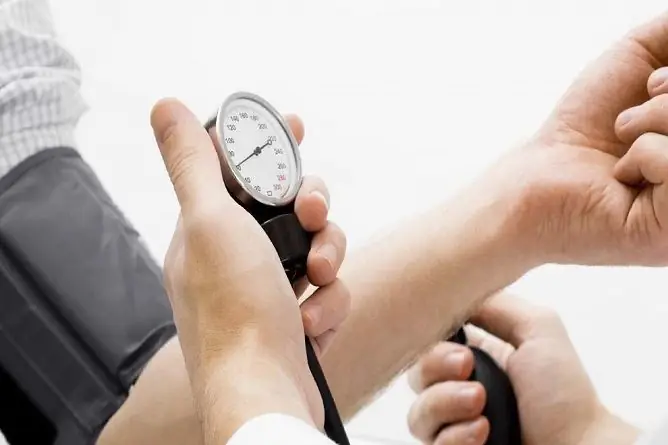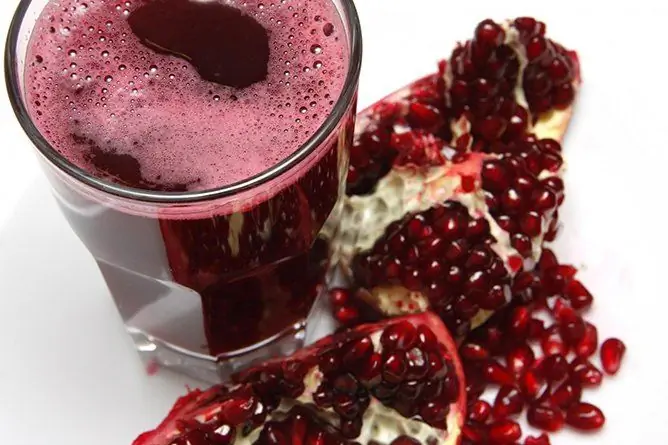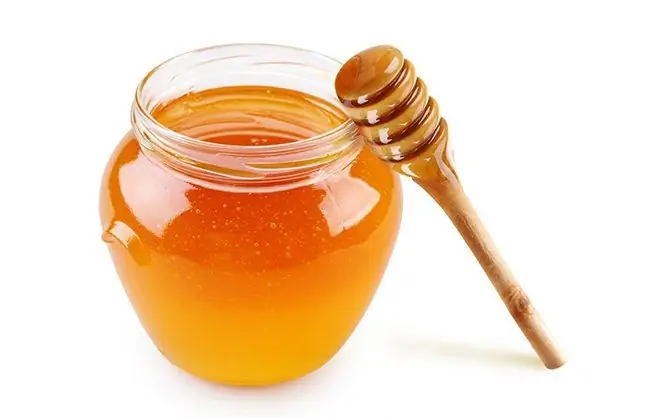- Author Rachel Wainwright [email protected].
- Public 2023-12-15 07:39.
- Last modified 2025-11-02 20:14.
How to increase blood pressure: how to effectively increase pressure at home
The content of the article:
- How to increase pressure at home quickly and effectively
- What is hypotension
- Types of arterial hypotension and the causes of its occurrence
- Signs of hypotension
- Prevention of hypotension
- Video
Anyone suffering from manifestations of hypotension should know how to increase blood pressure at home. It is believed that low blood pressure poses much less danger to life and health (with the exception of collapse, shock), but in fact it can lead to a significant deterioration in overall health, decreased mental and physical performance.

Blood pressure is considered low if it is less than 100/60 mm Hg. Art.
How to increase pressure at home quickly and effectively
Methods for treating arterial hypotension depend on its type and the reasons underlying the mechanism for lowering blood pressure. Acute hypotension requires immediate qualified medical attention. In this case, self-medication is dangerous for the patient's life.
Physiological hypotension, not accompanied by the appearance of any clinical symptoms, does not require treatment.
Chronic hypotension in most cases is not accompanied by a significant decrease in blood pressure and therefore it is quite possible to improve a person's condition without pills. For example, the following folk remedies are quite effective:
- Pomegranate juice. Every day you should drink half a glass of freshly squeezed juice diluted with boiled water in a 1: 1 ratio. You can sweeten it with a teaspoon of honey if desired. To prevent the negative effects of pomegranate juice on tooth enamel, it is best to drink it through a cocktail straw.
- Infusion of cinnamon. Drinking cinnamon infusion is a very effective way to increase blood pressure for a long time. To prepare it, pour a quarter teaspoon of cinnamon with a glass of boiling water. Insist for 15-20 minutes. Add 2-3 teaspoons of honey to the drink and drink half a glass twice a day on an empty stomach.
- A sandwich with honey and cinnamon. With a slight decrease in pressure, you can eat a piece of white bread, spread it with honey and sprinkle with cinnamon. This method promotes a mild increase in blood pressure, while being absolutely safe (with the exception of diabetes mellitus). Therefore, it can be recommended not only for an adult, but even for a child or teenager.
- Salty food. Very quickly helps to cope with manifestations of hypotension and a small piece of salty food. The fact is that sodium ions contribute to the retention of fluid in the body, which ultimately allows an increase in pressure. However, this method can only be used by people who do not have inflammatory diseases of the genitourinary system.
Drinks rich in caffeine (strong tea, coffee) allow you to increase the pressure. It should be borne in mind that caffeine binds to milk proteins, after which its effect is less pronounced. Therefore, if you need to increase the pressure quickly, then you should prepare and drink coffee without milk.
If folk remedies do not help, then the doctor may recommend tonic herbal preparations (tincture of Eleutherococcus, ginseng, Chinese magnolia vine).
Drug therapy for chronic hypotension is rarely used. This is due to the fact that hypotensive patients have impaired regulation of vascular tone, which is why their intake of drugs can lead to significant vasospasm and a sharp increase in pressure, up to the development of a hypertensive crisis.
Often, one of the first manifestations of pregnancy is a decrease in blood pressure. Therefore, before giving any means to increase it to a girl or woman of childbearing age, you need to make sure that they do not have pregnancy, since in the early stages many medicines and even herbal remedies are contraindicated.
What is hypotension
According to the WHO, the level of normal blood pressure ranges from 100/60 to 139/89 mm Hg. Art. (millimeters of mercury). If the blood pressure drops below 100/60 mm Hg. Art. and does not return to normal levels for a long time, this condition is called hypotension, or arterial hypotension.
Blood pressure tends to increase with age. This is due to a change in the morphology of the vascular walls (loss of elasticity, the formation of cholesterol plaques) and a decrease in myocardial contractility. Thus, the pressure is 100/70 mm Hg. Art. is normal for a young person, but is regarded as low for an elderly person.
Types of arterial hypotension and the causes of its occurrence
It is impossible to answer the question of what to do at low pressure without knowing the reasons that led to the development of this condition.
According to the characteristics of clinical manifestations, the following types of hypotension are distinguished:
- Sharp. Blood pressure drops suddenly and dramatically. This condition is often observed against the background of myocardial infarction, severe arrhythmias, pulmonary embolism, massive bleeding, and severe allergic reactions. Therefore, if the pressure dropped significantly and quickly, then an ambulance should be urgently called to the patient.
- Chronic. Blood pressure remains low for a long time, without falling to critical values.
In turn, chronic arterial hypotension is subdivided into several types:
- Physiological. It is observed in athletes and some people with a hereditary predisposition to low blood pressure. It is not accompanied by the development of clinical symptoms and does not need treatment.
- Primary (idiopathic, essential). It is an independent disease, the development of which leads to a neurosis-like syndrome of lesion of the vasomotor center of the brain. A huge role in the development of this pathology belongs to chronic stress and prolonged psychoemotional overstrain.
- Secondary. It develops against the background of a number of other diseases. For example, gastric ulcer and duodenal ulcer, rheumatism, tuberculosis, cystitis, diabetes mellitus, hepatitis, osteochondrosis of the cervical spine, heart failure, intoxication can lead to its occurrence. Also, prolonged fasting, a lack of pantothenic acid, vitamins B, C and E leads to secondary hypotension.
The main causes of low blood pressure are:
- physical fitness of the body;
- adaptation to climatic conditions (living in high mountains, in the tropics or subtropics);
- heart failure;
- a sharp decrease in the volume of circulating blood (massive burns, blood loss, indomitable vomiting, diarrhea);
- decreased tone of arterial vessels (septic or anaphylactic shock);
- trauma to the brain and / or spinal cord;
- chronic fatigue syndrome;
- chronic lack of sleep;
- psychological trauma;
- neuroses;
- therapy with antihypertensive drugs;
- endocrine system diseases;
- sepsis.
People taking antihypertensive medications and elderly patients may experience a condition called orthostatic hypotension. It is characterized by a rapid decrease in blood pressure at the time of the transition of the body from a horizontal position to a vertical one.

Hypotension requires correction only when it causes unpleasant symptoms
Signs of hypotension
In many people, hypotension does not manifest itself with any unpleasant signs, respectively, the question of how to raise blood pressure at home is not in front of them. But there are those to whom low blood pressure causes a lot of discomfort and is accompanied by the development of the following symptoms:
- weakness;
- irritability;
- weather dependence;
- emotional lability;
- sleep disorders;
- memory impairment;
- headache and dizziness;
- violation of thermoregulation;
- palpitations and shortness of breath on exertion.
Prevention of hypotension
The best way to prevent episodes of a significant decrease in blood pressure in hypotensive patients is to lead a healthy lifestyle.
This concept includes:
- rational balanced nutrition, sufficient content in the diet of fresh vegetables, herbs, fruits;
- compliance with the daily routine;
- good rest on weekends and during labor leave;
- avoidance of stressful situations;
- carrying out procedures to strengthen blood vessels and regulate their tone (swimming, hydromassage, contrast shower, massage).
Video
We offer for viewing a video on the topic of the article.

Anna Aksenova Medical journalist About the author
Education: 2004-2007 "First Kiev Medical College" specialty "Laboratory Diagnostics".
Found a mistake in the text? Select it and press Ctrl + Enter.






